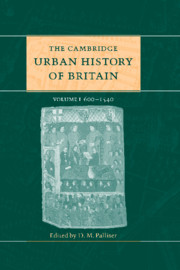Book contents
- Frontmatter
- Part I Introductory
- Part II The early middle ages 600–1300
- Part III The later middle ages 1300–1540
- 12 General survey 1300–1540
- 13 Government, power and authority 1300–1540
- 14 The economy of British towns 1300–1540
- 15 Urban culture and the Church 1300–1540
- 16 The built environment 1300–1540
- 17 London 1300–1540
- 18 The greater towns 1300–1540
- 19 Port towns
- 20 Small towns 1270–1540
- Part IV Regional surveys
- Part V Conclusion
- Appendix: Ranking lists of English medieval towns
- Select bibliography
- Index
- References
20 - Small towns 1270–1540
from Part III - The later middle ages 1300–1540
Published online by Cambridge University Press: 28 March 2008
- Frontmatter
- Part I Introductory
- Part II The early middle ages 600–1300
- Part III The later middle ages 1300–1540
- 12 General survey 1300–1540
- 13 Government, power and authority 1300–1540
- 14 The economy of British towns 1300–1540
- 15 Urban culture and the Church 1300–1540
- 16 The built environment 1300–1540
- 17 London 1300–1540
- 18 The greater towns 1300–1540
- 19 Port towns
- 20 Small towns 1270–1540
- Part IV Regional surveys
- Part V Conclusion
- Appendix: Ranking lists of English medieval towns
- Select bibliography
- Index
- References
Summary
numbers and location of small towns
A first stage in understanding late medieval small towns must be to ask how many there were, and where they were located. But how do we recognise the small towns among the thousands of rural settlements? Those places can be identified which enjoyed the status of boroughs (in England and Wales) and burghs in Scotland. But that can only initiate the inquiry, because we know that many small boroughs and burghs existed only in law and never developed into urban settlements. Other places, especially in eastern England, became towns without gaining the privileges of a borough. The clerks used the word ‘vill’ to describe both rural and urban places, and in doing so echoed common speech, in which a wide range of settlements were called ‘towns’. Without clear guidance from contemporary terminology, we must apply our definition of a town, searching for evidence of a compact and permanent settlement, in which a high proportion of the inhabitants pursued a variety of nonagricultural occupations. In addition, we might hope to find that the town served as the commercial, administrative or religious centre of its locality, and that it had the topographical characteristics of closely set houses, narrow plots and a market place.
Small towns are defined here arbitrarily as containing fewer than 2,000 inhabitants. Places have accordingly been excluded if they are found to exceed that figure at any time in the period, but some of them did not remain consistently large. No lower limit has been imposed, though we would expect that most towns would be larger than the surrounding villages, and in practice the great majority of small towns had populations in excess of 300.
- Type
- Chapter
- Information
- The Cambridge Urban History of Britain , pp. 505 - 538Publisher: Cambridge University PressPrint publication year: 2000
References
- 7
- Cited by



